Tag Archive: intervention
July 8, 2012
by Carole Zangari -
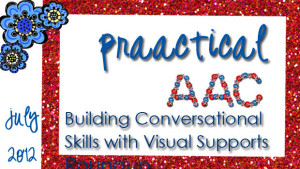
A young AAC user whom I know shared a story with me recently about feeling left out and struggling to find out why. Although she is smart, has age appropriate receptive language, and good command of her high tech SGD, building and maintaining friendships is a struggle. One of the things we’ll be doing to make changes in that area is to learn more about what makes a good conversation, adding vocabulary to make small talk easier, and practicing that. – Here’s a nice video, from Autism Teaching Strategies, that shows how to use visual supports and music to help learners remember to use some of the conversational continuers. Although Joel Shaul demonstrates this with visual supports that have words and phrases, the strategy works just as well with pictures for pre-literate communicators. – – Enjoy!
Filed under: Video of the Week
Tagged With: Conversation, intervention, pragmatics, visual supports
July 7, 2012
by Carole Zangari -
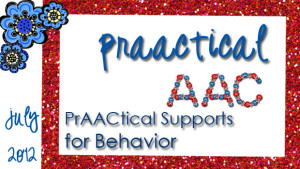
Rachel arrives to therapy tense and upset. Mauro gets frustrated when the clinician presents new activities. Brianna starts to bang the table when demands are placed on her. Zach becomes agitated when he has to wait for something he wants. – Like any set of tools and strategies, AAC works best when the communicator is relaxed, confident, and engaged. Our July Strategy of the Month focuses on PrAACtical Supports for Behavior. We hope to share ideas for planning therapy sessions that help AAC learners stay focused, calm, and engaged. — We’re big believers in the old adage that an ounce of prevention is worth a pound of cure. So, what can we do to prevent or minimize problems like the ones experienced by Rachel, Mauro, Brianna, and Zach? The answers have to do with having clear and appropriate expectations, and using visual and AAC supports effectively. When used consistently, these strategies... [Read More...]
Filed under: Strategy of the Month
Tagged With: aided language input, ASD, behavior, countdown board, developmental disability, first then, intervention, picture schedule, positive behavior support, transition, visual supports
June 27, 2012
by Carole Zangari -
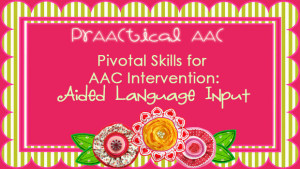
We can’t seem to stop talking about the power of aided language input. It’s one of those strategies that make our sessions more effective and make our clinicians more comfortable with the learner’s AAC system. And when other team members see us using it, they can’t help but pick up on the importance of aided modeling for people who are still learning to use their communication boards, books, SGDs, and mobile devices. – Modeling, AAC Style (clinical rationale, research supports) AACtual Progress: Learning to use Aided Language Input (lessons learned) Strategy of the Month: Aided Language Input (screencast overview) Using the Device/App: Getting the Team on Board (implementation) Teachers in AACtion: Aided Language Input (video) Why We Love Aided Language Input (clinical rationale) Curated Resources for Aided Language Input (miscellaneous info, videos) Video of the Week: Aided Language Input Demo (video) 5 Tools to Make Aided Language Input Easier –
Filed under: PrAACtical Thinking
Tagged With: aided language input, intervention
June 26, 2012
by Carole Zangari -

SLPs love to talk, of course, but sometimes that works against us. Over-prompting. Jumping in to repeat the last question. Re-phrasing the previous comment. Nature abhors a vacuum and sometimes we just can’t stop ourselves. What makes us fun at parties, though, can make it difficult for our AAC friends to become active, assertive communicators. Too much verbiage on our part can really slow down the journey toward communicative independence. We know better. We really do. But sometimes we need a little help to remind ourselves. And, so, a few reminders to us all… 1. Make the expectations clear using visual supports and aided language input. 2. Create a motivating context in which the learner needs to communicate in order to get his/her own agenda met. 3. Pause. Look expectantly at the communicator. Pause some more. Look even more expectant. 4. Keep pausing. Use a gesture for emphasis (e.g., cup... [Read More...]
Filed under: PrAACtical Thinking
Tagged With: intervention
June 24, 2012
by Carole Zangari -
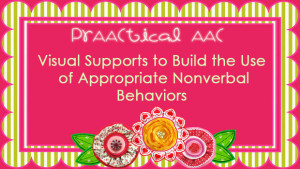
Most of our posts are about teaching language, but today we take a little side trip into nonverbal communication. We’ve all worked with folks who have difficulty maintaining appropriate distance and making eye contact, and know how problems in these area can really impede a person’s ability to relate well to others. Our video for this week, from Autism Teaching Strategies, illustrates how to use pictures supports to teach appropriate nonlinguistic conversational behaviors. – Of course, we were drawn to it because of our own experience that using pictures as a reminder is much easier to fade than oral language prompts (e.g., ‘Don’t forget to look at me when you talk;’ ‘Quiet hands’). – What we also love about this video is the teaching strategy: role reversal. In this strategy, the SLP (or teacher/parent) provides a model of both positive and negative examples of the target skill. The learner’s job... [Read More...]
Filed under: Video of the Week
Tagged With: Conversation, intervention, visual supports
June 17, 2012
by Carole Zangari -

This week, we’ve been talking about feedback as a language facilitation strategy and when I came across this video of a mom interacting with her deaf or hard of hearing daughter, I knew it was worth sharing. What I love about this video is how consistently the mom both provides good models and responds contingently to her daughter’s utterances. Watch how she skillfully avoids over-interpreting the little girl’s message and how effective that is in getting her daughter to use more complex language. I wonder if she ever considered a career as an SLP… –
Filed under: Video of the Week
Tagged With: home, intervention
June 16, 2012
by Carole Zangari -

This month we’ve been talking about ways to use traditional language facilitation strategies with people who use AAC. So far, we’ve covered expansion and extensions and recasts. This week we talk about feedback. Feedback is a critical component of any learning experience. It functions as a signpost and let’s us know where we are relative to our destination. Let’s think about how we can use it to improve the language of people who use AAC. – Contingent Responses What we do and say after the AAC learner communicates can be a powerful way to impact patterns of language use. The cardinal rule in AAC intervention is to provide consequences that are contingent on what was communicated. So, if the beginning AAC learner requested a something they don’t really like by mistake, we’d still provide that item and have them interact with it briefly before giving them a chance to make a different choice.... [Read More...]
Filed under: Strategy of the Month
Tagged With: intervention, language
June 16, 2012
by Carole Zangari -
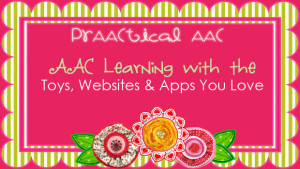
One of the best things about being an AAC interventionist is that it allows you to play and find creative ways to teach and practice language. In this post, we’ve compiled some of our favorite posts about teaching core vocabulary, early communicative intents, and more advanced language skills to people learning AAC. – – Early Language Magic Moments with Toca Store (app) Magic Moments with Toca Boca Doctor (app) PrAACtical Play with Playskool Busy Gears (toys) Magic Moments with Stop and Go (app) HijAACked! Putting an AAC Twist on The Hallelujah Flight (free e-book, website) Magic Moments with Disneyland Explorer (app, free) Magic Moments with Painting with Time (app, free) 5 Apps to Tempt Commenting and Other Language Functions (app) – More Advanced Language Magic Moments: AAC Intervention with BrainPOP (app and website) Magic Moments with Qwiki (app and website) HijAACked! AAC & Anti-Bullying with Stand Tall, Marylou Melon (free... [Read More...]
Filed under: PrAACtical Thinking
Tagged With: implementation ideas, intervention, therapy activties
June 13, 2012
by Carole Zangari -
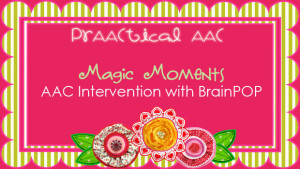
There’s so much to love about BrainPOP. Geared for students in 4th-12th grades. Solid curricular content. Engaging animation and really fun educational games. Aligned with Common Core. Searchable by learning standard, subject, or grade level. Built-in assessment. Evidence-based. Web-based and app versions. Closed captioned videos. English and Spanish editions. Additional resources for educators. A simplified version for younger learners. And lots of it for free! – I’ve just scratched the surface of this wonderful site, which has been around since 1999, and is growing in depth and breadth. It’s perfect for some of the older students with whom we work and has a lot of potential for AAC learning. – Magic Moments: Ideas for AAC Intervention with BrainPOP 1. Navigation: Even some of our older students are still learning to find their way around complex AAC systems. The engaging content in the BrainPop videos create a fun context for activities... [Read More...]
Filed under: PrAACtical Thinking
Tagged With: intervention, language, Magic Moments
June 3, 2012
by Carole Zangari -

Last week, we visited with a wonderful early intervention team who is committed to helping their program better serve babies and toddlers with AAC needs. Like any program, funds are limited and while we talked a bit about high tech AAC equipment, most of our conversation was about how simple solutions can make a big difference. – Simple is good. – We love finding low-cost ways to help children play, sit, move, learn, and communicate. But buying or making the materials is just the beginning. The real power comes from figuring out how to use it to give children control and allow them to be actively involved in the world around them. – For this week, we return to SET BC for their outstanding 3-part series by Susie Blackstien-Adler on this topic. Each segment of the Simple Technology for Participation series is less than 30 minutes long and is full... [Read More...]
Filed under: Video of the Week
Tagged With: intervention, low tecg, no tech









